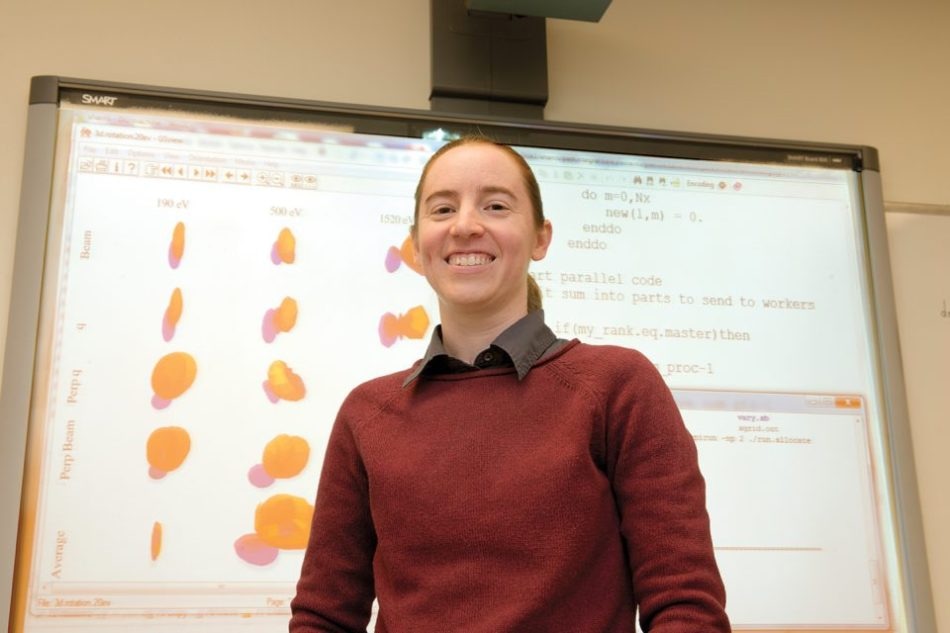Mar 21 2017
A jumble of letters and numbers fills the computer screen. To an untrained onlooker, the lines may look like gibberish, but it is actually a computer code key to understanding the smallest pieces of the universe.
 Illinois State Physics Professor Allison Harris standing in front of a whiteboard displaying her research. (Credit: Illinois State University)
Illinois State Physics Professor Allison Harris standing in front of a whiteboard displaying her research. (Credit: Illinois State University)
Allison Harris, an assistant professor of physics at Illinois State University, is the author of the code. Harris researches quantum physics by studying atomic collisions. Her work deals with the tiniest particles—those on the atomic and subatomic levels.
All matter is composed of atoms. Atoms are so tiny that a cube of sugar has as many atoms as there are stars in the universe. An atom is the smallest amount of matter that retains the properties of an element. Think of it as the smallest known building block of hydrogen that is still recognizable as hydrogen.
But atoms are not the most fundamental pieces of matter. They are composed of even smaller—subatomic—particles. Atoms have a nucleus surrounded by electrons (negatively charged particles). Inside the nucleus are protons (positively charged particles) and neutrons (particles with no electric charge).
How these particles interact, or more precisely, what happens when a single one of these charged particles collides with an atom, is what fascinates Harris. “My job is to make predictions. If you shoot a proton at an atom, where does the proton go?” said Harris.
To help people grasp what she is studying on a subatomic scale, Harris uses a much, much larger example of the forces at work. “NASA scientists can launch a rocket that has a rover on it and land it on an asteroid. We’ve seen them do it, and it’s really amazing,” said Harris.
“They deal with the gravitational forces that are pulling on the rocket—from the nearby planets and moons, and from the asteroid itself. They all impact the rocket’s path.”
On a much smaller scale, it’s not gravity that affects a charged particle as it flies into an atom, but instead it’s the electric force. “Take a charged particle, like a proton, and shoot it at an atom of helium or hydrogen. Now you have multiple charged particles interacting,” Harris said. “I try to answer the fundamental questions. What is going to happen when that particle collides with the atom?”
Harris works with complex calculations that generate possible paths a free-flying proton might take when it slams into an atom. Glancing at the screen of code, Harris gives a slightly sheepish smile. “I work in Fortran language for coding, which would make computer programmers laugh because it is so old, but it works great for science computation,” she said.
The code she and her undergraduate students generate is fed into one of the 64-processor units in the Department of Physics (a laptop generally has two processors). From there, they analyze and share the results of their computer simulations. Her theoretical computations are used in collaboration with experiments performed in laboratories in China, Germany, Australia, and the United States. Last fall she presented her work in Germany, and her work has been published in international scientific journals, such as the Journal of Physics and Physical Review. Her research is funded by a $100,000 National Science Foundation grant.
“This is a methodology that has been used very successfully in high-energy physics but is new to atomic collisions,” said Department of Physics Chair Dan Holland. “Proof of the novelty and potential for the idea is that the National Science Foundation has awarded her a three-year grant.”
Harris’ development of the theory and the code are unique in her field. Previously, similar types of calculations have been used in high-energy quantum physics, where man-made collisions happen at crushing speeds at locations such as CERN (European Organization for Nuclear Research) and the Fermilab (Fermi National Accelerator Laboratory). “The people at colliders like CERN are interested in smashing nuclei together and blowing them apart—which is very cool,” Harris said with a smile. “But I’m more interested in the path tiny particles take when they collide at much slower speeds.”
No matter the pace of particle collisions, the world of quantum physics throws a lot of curveballs that complicate predictions. “It’s funny. We know more about how to crash that rocket into an asteroid than we do about the dynamics of particles at the atomic scale,” said Harris.
For one thing, working on the atomic scale means that the peculiarities of quantum mechanics come into play. “There is something called the uncertainty relationship, which tells us that in quantum mechanics you cannot know an object’s position and momentum at the same time,” said Harris. That means a scientist may know where a particle is located at a certain point in time but cannot know how fast it is moving, or vice versa.
Therefore, the calculations Harris and her students perform are based on the idea that in quantum mechanics, particles behave very differently than they do in the classical world.